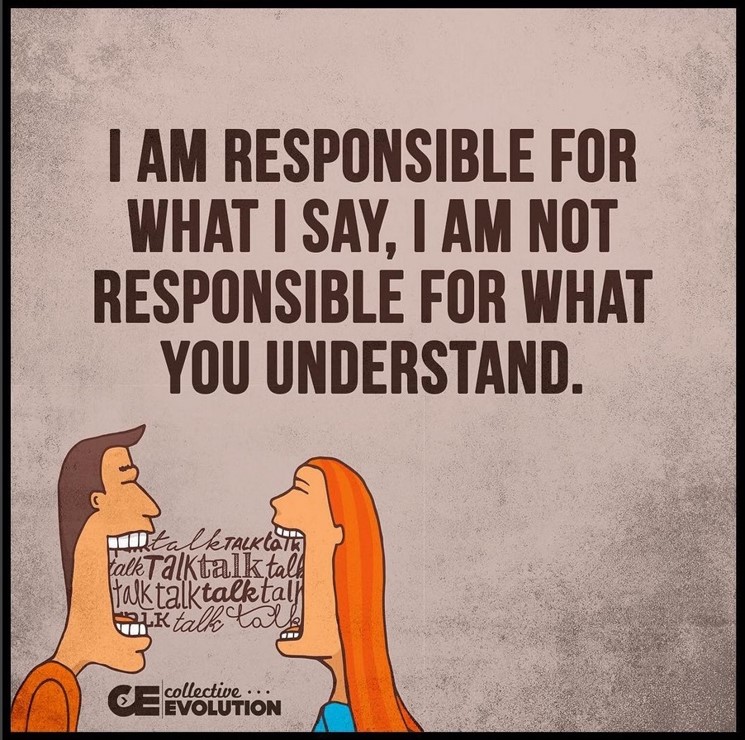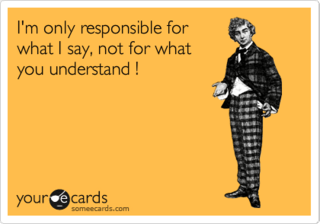The day I wrote this article about how to help your audience listen better, I received this e-card with its remarkable message:
I’m only responsible for what I say, not for what you understand.
I realise it’s supposed to be a joke (maybe?). But at the same time, it’s fairly indicative of the world we live in now.
There seem to be a lot of people who are only interested in talking and never concerned with listening.
Technically, that’s not communications.
That’s called propaganda.
Why People Communicate in Business
Let’s start with a few basics.
Whether in a big conference, a small meeting or casually in the hallway, people in business typically communicate for a specific reason: to bring alignment between the Speaker and the Receiver.
In other words, the Speaker is probably talking because someone isn’t doing what the Speaker wants them to do. The Speaker could be talking directly to the Receiver, or talking indirectly to another audience via the Receiver, like customers, team members, senior management, vendors, etc.
The most basic format for communicating falls into three parts:
- I have a recommendation about a particular topic
- Here’s why I believe it’s the best solution (the rationale behind the reco)
- I’d like your agreement or approval
Using the image as an example, if the speaker can’t get the audience to understand …
- What they want
- Why and when they want to do it, and
- How they plan to accomplish it …
Nothing will happen.
As leader, if you can’t explain, justify, motivate (among many others), you aren’t leading. Period.
It’s one thing to talk. It’s another to help the audience listen more effectively. To be a successful communicator, the sender’s primary objective should be to do everything possible to get the audience to:
- Listen first and foremost. Only when the audience listens will the next two occur.
- Understand the message
- Act upon the message
Top 10 Suggestions to Help Your Audience Listen Better
Below I’ve gathered 10 steps I follow when I think about how and what I communicate. Some of the suggestions have more details posts elsewhere, so I’ve provided links if you want more information.
Related to this thread, you might also like this article on How to Prepare a Presentation in Six Questions.
1. Get to the point.
When the conversation is important, the audience shouldn’t have to read, watch or listen to you organise your thoughts on the spot. At least consider why you’re talking and what you want to say. This sounds trite, I’m sure but you don’t get a second change to make a first impression, even when you know the other party!
Go here: Get To The Point
2. Who is your audience, Part 1
Who are you talking to? What type of audience do you have? Hint: which one is the Decision Maker?
Go here for more depth: Three Different Types of Audiences
3. They need to listen to you, not listen to the little voice in the back of their hears.
Some audience members aren’t listening to you because they’re too busy listening to themselves! You need to know: what is their Little Voice telling them?
Go here: Self-Talk
4. Structure your messages.
All communications need structure, and the tool the Message House is the best tool to help you do this.
Go here; The Rule of 3s
5. Balance the presentation with a conversation.
It’s easy to think when you do all the talking, it’s easy to listen. But does it? There’s more of a challenge to listening – or at least listening more effectively –when they have more incentive. Instead, try to build a conversation into the presentation so your audience is more engaged.
Go here: Presentation vs Conversation
6. Use strong non-verbal communications skills, like gestures, voice, eye contact.
It’s not just your words you need to pay attention to, you also need to use non-verbal skills to engage the audience, such as eye contact, gestures, voice and silence.
Go here: Eye Contact
Or here: Strong Voice
And here: Gestures
7. Minimise distractions, both yours and theirs
There’s essentially two different types of noise:
- Noise inside your head (that’s self-talk, or #3 above)
- Noise outside your head, which frequently is noise inside your audience’s head
Noise outside your head is either 1) physical noise, although you could get visual noise such as something shiny, or an abrupt movement that takes the eye (and the person’s attention) away from you.
More commonly, noise inside the audience’s head can be roken down into specific aspects, such as:
- Psychological – anything that affects the mind when thinking
- Physical – tangible noise
- Technological – any problems electronic or digital
- Physiological – anything related to how the human body works
- Semantic – anything related to language
Noise is discussed in more detail in a post about the Communications Equation entitled How Communications Works, Step by Step.
8. Remind them why it’s important to them, not you.
Concentrated listening is extremely difficult. It’s never a bad idea at the end of your speech or converstaion to summarise.
9. Ask for feedback, and ask questions of the audience.
After you’re finished, ask questions of the audience.
10, End early.
The longer your communicate, the less people remember.
Any other thoughts or suggestions on how you can help the audience listen better? Please add your comments or thoughts below.



No comment yet, add your voice below!